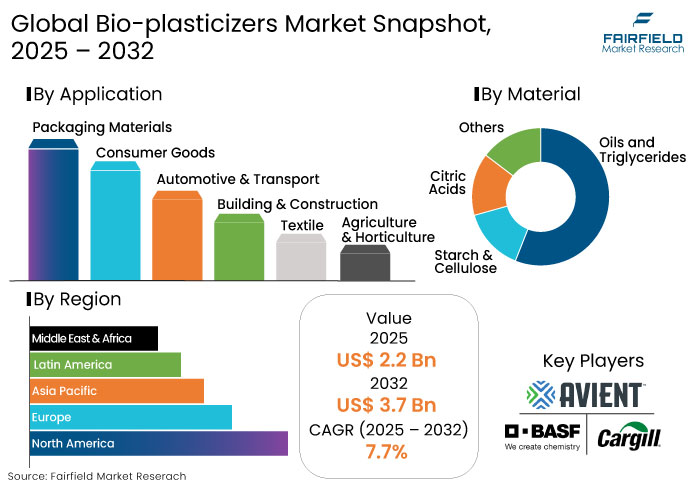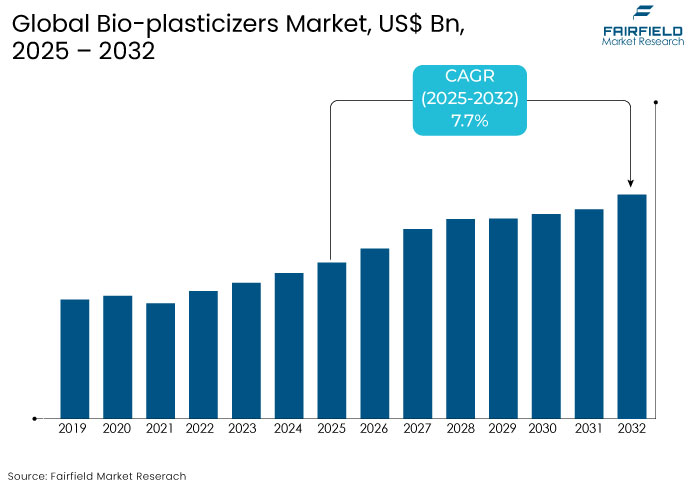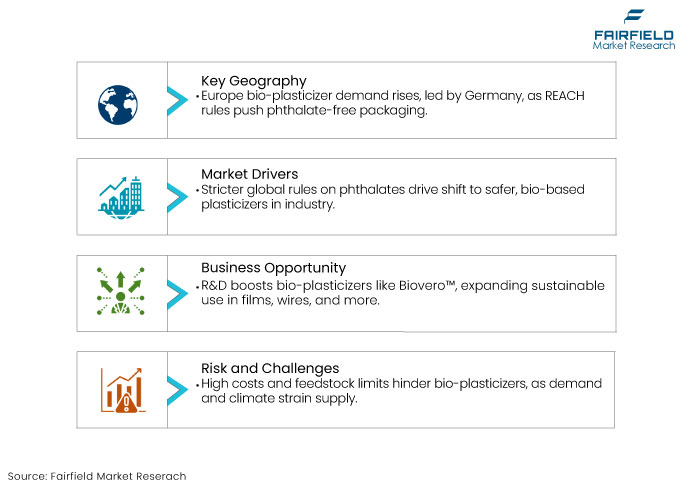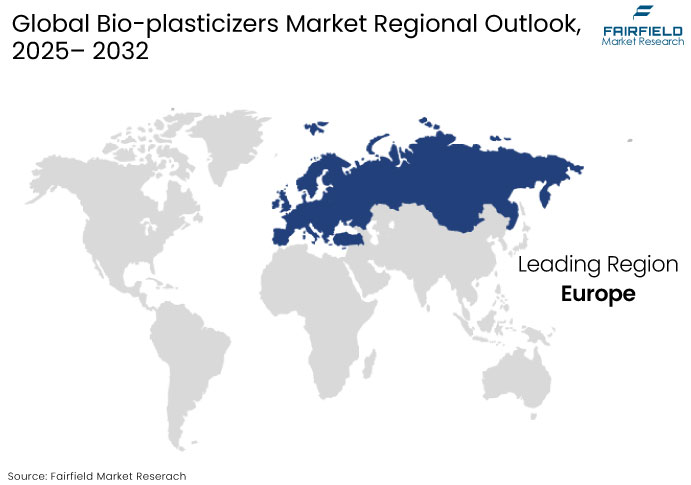Global Bio-plasticizers Market Forecast
- The bio-plasticizers market size is set to expand with a 7.7% CAGR during 2025 to 2032. The market is expected to grow from US$ 2.2 Bn in 2025 to US$ 3.7 Bn by the end of the forecast period.
- Rising demand for eco-friendly, bio-based materials in the plastics industry is significantly boosting the adoption of bio-plasticizers as sustainable alternatives to conventional phthalate-based plasticizers.

Bio-plasticizers Market Insights
- The demand for bio-plasticizers in packaging is driven by the increasing need for sustainable, biodegradable, and recyclable materials in response to regulatory pressure and consumer preferences.
- Bio-plasticizers are gaining traction in consumer goods due to the growing shift towards non-toxic, eco-friendly materials in products such as cosmetics, personal care items, and packaging.
- In the automotive and transport sectors, bio-plasticizers are being adopted to meet stricter environmental regulations and the demand for lightweight, non-toxic materials in vehicle interiors and components.
- The building and construction industry is increasingly using bio-plasticizers to develop safer, sustainable materials that reduce environmental impact and comply with green building standards.
- Bio-plasticizers are becoming essential in textiles as manufacturers respond to consumer demand for eco-friendly, biodegradable materials with lower environmental and health impacts.
- The agriculture and horticulture sectors are adopting bio-plasticizers in biodegradable films, coatings, and fertilizers, driven by the push for environmentally responsible farming practices.
- Rising demand for sustainable and high-performance Bio-plasticizers in automotive and luxury goods is driving steady North American market growth.
- In Europe, the demand for bio-plasticizers is rapidly increasing across various industries, driven by stringent environmental regulations and consumer demand for sustainable, non-toxic materials, particularly in packaging, automotive, and consumer goods.
- In North America, bio-plasticizers are gaining traction as industries such as automotive, building & construction, and consumer goods push for eco-friendly materials to comply with environmental standards, reduce carbon footprints, and meet shifting consumer preferences for green products.
A Look Back and a Look Forward - Comparative Analysis
From 2019 to 2024, the global bio-plasticizer market experienced steady growth driven by increasing regulatory pressure to reduce dependence on petroleum-based additives and growing awareness of environmental sustainability. As bans on phthalates and other toxic plasticizers gained momentum—especially in Europe and North America industries began actively transitioning toward bio-sourced alternatives. The demand was particularly strong in packaging, medical devices, and consumer goods. The market also benefited from advancements in production techniques and rising consumer preference for safer, biodegradable materials.
Between 2025 and 2032, the market is expected to gain further traction as industries prioritize circular economy models and green certifications. Continued investments in R&D are likely to expand the applicability of bio-plasticizers across high-performance materials and engineering plastics. Supportive government policies and increasing adoption of green building practices will foster growth in the construction and automotive sectors. Additionally, emerging economies in Asia-Pacific and Latin America are projected to drive future expansion due to rising environmental consciousness and industrial modernization.
Key Growth Determinants
Increasing regulatory bans on phthalates and toxic plasticizers accelerate the demand for bio-based alternatives
Over the past decade, global regulatory bodies have tightened restrictions on phthalate-based plasticizers due to health risks like endocrine disruption and reproductive toxicity. The EU’s REACH regulation has limited the use of phthalates such as DEHP and DBP, while the U.S. FDA has revoked approvals for 25 phthalate plasticizers in food-contact applications. These moves are pushing industries toward safer, bio-based plasticizers that offer reduced toxicity and environmental impact.
This shift is spurring innovation in bio-based plasticizers made from renewable resources such as vegetable oils and citric acid. These alternatives meet strict safety standards while performing well in applications such as packaging, medical devices, and consumer goods. Growing consumer demand for sustainable, non-toxic materials further supports this transition, encouraging investment in eco-friendly plasticizer solutions. Consequently, the bio-plasticizer market is expanding rapidly, driven by regulatory pressure and the global push for greener materials.

Key Growth Barriers
High production costs and limited availability of bio-based feedstock pose significant challenges to scalability
High production costs and limited availability of bio-based feedstocks are major challenges for the bio-plasticizers market. Extracting raw materials from renewable sources, such as vegetable oils, is more complex and expensive compared to traditional plasticizers. Additionally, competition for these feedstocks from the food and biofuel industries exacerbates supply issues, while climate change impacts agricultural yields, further limiting the availability of bio-based inputs.
This scarcity, coupled with underdeveloped infrastructure for processing and distributing bio-feedstocks, makes large-scale production difficult. As demand for sustainable alternatives increases, the price volatility and supply chain constraints slow the market's growth, underscoring the need for investment in feedstock production and processing capabilities.
Bio-plasticizers Market Opportunity
Increased investments in R&D for next-gen, high-performance bio-based plasticizers can open new application avenues
Increased investments in research and development (R&D) for next-generation, high-performance bio-based plasticizers are unlocking new application avenues across various industries. For example, Cargill has expanded its bio-industrial solutions portfolio by introducing Biovero™, a bio-based plasticizer. Biovero™ is utilized in manufacturing products such as flooring, clothing, wires, cables, and plastic films and sheets. Initially launched in North America, there are plans to extend its availability globally. Cargill's investment in developing Biovero™ demonstrates the potential of bio-based plasticizers to serve diverse applications, offering sustainable alternatives to conventional plasticizers.
Such strategic R&D investments by industry leaders are pivotal in advancing the capabilities and applications of bio-based plasticizers. By enhancing performance characteristics and broadening application scopes, such investments are instrumental in driving the adoption of sustainable materials across various sectors.

Leading Segment Overview
Oils and triglycerides lead the growth in the global bio-plasticizers market
Oils and triglycerides, especially soybean and castor oils, dominate the global bio-plasticizers market due to their biodegradability, renewability, and strong polymer compatibility. Epoxidized soybean oil (ESBO) is widely adopted across industries for its plasticizing efficiency and thermal stability, making it a preferred substitute for phthalates. Leading chemical manufacturers have increasingly integrated ESBO in PVC applications, contributing to the growing share of oil-based plasticizers in eco-conscious sectors like packaging, automotive, and consumer goods.
Castor oil-based plasticizers are gaining momentum as they offer excellent migration resistance and maintain flexibility under extreme conditions. Companies like Emery Oleochemicals and Vertellus have expanded their product portfolios with bio-based plasticizers derived from these oils, catering to a wide range of industrial needs. The global shift toward safer, high-performance alternatives and increasing environmental regulations have positioned oils and triglycerides as critical inputs in next-generation plasticizer development, driving their sustained dominance in the global market.
Regional Analysis
- Surging demand for bio-plasticizers in Europe's plastic packaging industry
The demand for bio-plasticizers in Europe's plastic packaging sector is accelerating, driven by environmental regulations and consumer preferences for sustainable products. The European bio-plasticizers market is projected to grow at a CAGR of 8% from 2025 to 2032, with Germany leading in consumption, particularly of castor oil-based plasticizers. This growth is fueled by the EU's stringent policies, such as the REACH regulation, which restricts harmful phthalates, prompting industries to adopt bio-based alternatives.
Technological advancements and the push for a circular economy further bolster this trend. Innovations in bio-based plasticizers have enhanced their compatibility and performance, making them viable substitutes for traditional plasticizers. Additionally, initiatives like the EU Green Deal and the Circular Economy Action Plan support the transition towards sustainable materials. As industries like packaging and automotive increasingly prioritize eco-friendly solutions, the adoption of bio-plasticizers is expected to continue its upward trajectory.

- Sustainability push fuels bio-plasticizer demand in Asia Pacific’s textile and agriculture sectors
The Asia Pacific region is witnessing a significant surge in demand for bio-plasticizers within the textile and agriculture sectors, driven by environmental concerns and regulatory measures. In India, the textile industry contributes approximately 2.3% to the nation's GDP and 11.4% to total exports, highlighting its economic significance. This sector's expansion, coupled with a global shift towards sustainable materials, is propelling the adoption of bio-plasticizers, which offer eco-friendly alternatives to traditional plasticizers. Similarly, in agriculture, bio-plasticizers are being utilized to produce biodegradable films and equipment, aligning with the region's push for sustainable farming practices.
Manufacturers across Asia Pacific are actively adopting bio-plasticizers to meet rising sustainability standards and environmental regulations. In both textiles and agriculture, these alternatives are helping reduce dependence on harmful chemicals while improving product safety and biodegradability. Supportive government policies and growing consumer demand for eco-friendly products are accelerating this shift. As industries seek to align with global green trends, bio-plasticizers are becoming integral to future-ready production processes.
- Rising adoption of bio-plasticizers in North America's automotive and transportation industry
The automotive and transportation sectors in North America are increasingly adopting bio-plasticizers, driven by a commitment to sustainability and stringent environmental regulations. Bio-plasticizers, derived from renewable sources like soybean and castor oil, are being utilized in vehicle interiors, wiring insulation, and under-the-hood components due to their flexibility, durability, and reduced environmental impact. This shift is further propelled by the industry's focus on lightweight materials to enhance fuel efficiency and reduce emissions. As a result, bio-plasticizers are becoming integral to modern automotive manufacturing processes.
Technological advancements and regulatory support are further accelerating the adoption of bio-plasticizers in the automotive industry. Innovations in bio-based materials have enhanced the performance characteristics of bio-plasticizers, making them suitable for high-temperature and high-stress applications. Regulatory bodies like the U.S. Environmental Protection Agency (EPA) are promoting the use of safer, non-toxic alternatives to traditional plasticizers, encouraging manufacturers to transition towards bio-based options. This convergence of innovation and policy is solidifying the role of bio-plasticizers in the future of sustainable automotive design.
Competitive Landscape
The global bio-plasticizer market is characterized by intense competition, with key players focusing on sustainability-driven innovation, strategic collaborations, and capacity expansions. Leading companies such as BASF SE, Evonik Industries AG, Lanxess AG, and Emery Oleochemicals dominate the market through diversified product portfolios and strong R&D capabilities.
Many players are shifting from traditional phthalates to bio-based alternatives derived from renewable sources like castor oil, soybean oil, and citrates to align with regulatory compliance and consumer demand. Start-ups and niche manufacturers are entering the market with tailored solutions, particularly in packaging, automotive, and medical applications, adding to the competitive dynamics.
Additionally, partnerships with end-use industries and investments in bio-refinery technologies are becoming common strategies to secure market position. The competitive landscape is expected to evolve rapidly as manufacturers respond to tightening environmental regulations and rising pressure from global sustainability initiatives.
- In March 2024, Baerlocher USA, a division of the Baerlocher Group, and Innoleics, a U.S. innovator in bio-based plasticizers, announced a partnership. Baerlocher USA became the exclusive distributor of Innoleics' full line of bio-based plasticizers for flexible polyvinyl chloride (PVC) applications in the U.S., enhancing access to sustainable materials.
- In May 2023, Origin Materials and Indorama Ventures formed a strategic partnership to scale the production of bio-based materials, advancing sustainable solutions in the PET resin industry.
Key Companies
- Avient Corporation
- BASF SE
- Cargill, Incorporated
- DIC Corporation
- Dow, Inc.
- Evonik Industries AG
- LANXESS
- Jungbunzlauer Suisse AG
- ACS Technical Products
- Emery Oleochemicals
- Matrìca S.p.A.
- Roquette Frères
- Goldstab Organics Pvt. Ltd.
- GRUPO PRINCZ IPASA
An Expert’s Eye
- The global bio-plasticizers market is experiencing significant growth, driven by increasing regulatory pressure and consumer demand for eco-friendly alternatives to traditional phthalate-based plasticizers. Manufacturers are shifting toward bio-based solutions to meet stricter environmental regulations and align with sustainability goals.
- Continuous innovation in bio-plasticizers, particularly in sourcing from renewable materials like castor oil, soybean oil, and citrates, is enhancing product performance. This technological progress is making bio-plasticizers viable for a wider range of applications, from automotive to packaging.
- While bio-plasticizers initially faced challenges in terms of cost and performance consistency, advancements in manufacturing processes have made them more cost-competitive. Their improved functionality in high-performance plastics is accelerating adoption across industries.
- Major plastic producers are gradually transitioning to bio-plasticizers as part of a broader shift toward sustainable material usage. This move is particularly visible in the automotive, construction, and packaging sectors, which are increasingly incorporating bio-based solutions in response to both regulatory demands and shifting consumer preferences.
Global Bio-plasticizers Market is Segmented as-
By Material Type
- Oils and Triglycerides
- Starch and Cellulose
- Citric Acids
- Others
By Application
- Packaging Materials
- Consumer Goods
- Automotive & Transport
- Building & Construction
- Textile
- Agriculture & Horticulture
- Others
By Region
- North America
- Europe
- Asia Pacific
- Latin America
- Middle East & Africa
1. Executive Summary
1.1. Global Bio Plasticizers Market Snapshot
1.2. Future Projections
1.3. Key Market Trends
1.4. Regional Snapshot, by Value, 2025
1.5. Analyst Recommendations
2. Market Overview
2.1. Market Definitions and Segmentations
2.2. Market Dynamics
2.2.1. Drivers
2.2.2. Restraints
2.2.3. Market Opportunities
2.3. Value Chain Analysis
2.4. COVID-19 Impact Analysis
2.5. Porter's Fiver Forces Analysis
2.6. Impact of Russia-Ukraine Conflict
2.7. PESTLE Analysis
2.8. Regulatory Analysis
2.9. Price Trend Analysis
2.9.1. Current Prices and Future Projections, 2024-2032
2.9.2. Price Impact Factors
3. Global Bio Plasticizers Market Outlook, 2019 - 2032
3.1. Global Bio Plasticizers Market Outlook, by Source, Value (US$ Bn) & Volume (Tons), 2019-2032
3.1.1. Oils and Triglycerides
3.1.2. Starch and Cellulose
3.1.3. Citric Acids
3.1.4. Others
3.2. Global Bio Plasticizers Market Outlook, by Application, Value (US$ Bn) & Volume (Tons), 2019-2032
3.2.1. Packaging Materials
3.2.2. Consumer Goods
3.2.3. Automotive & Transport
3.2.4. Building & Construction
3.2.5. Textile
3.2.6. Agriculture & Horticulture
3.2.7. Others
3.3. Global Bio Plasticizers Market Outlook, by Region, Value (US$ Bn) & Volume (Tons), 2019-2032
3.3.1. North America
3.3.2. Europe
3.3.3. Asia Pacific
3.3.4. Latin America
3.3.5. Middle East & Africa
4. North America Bio Plasticizers Market Outlook, 2019 - 2032
4.1. North America Bio Plasticizers Market Outlook, by Source, Value (US$ Bn) & Volume (Tons), 2019-2032
4.1.1. Oils and Triglycerides
4.1.2. Starch and Cellulose
4.1.3. Citric Acids
4.1.4. Others
4.2. North America Bio Plasticizers Market Outlook, by Application, Value (US$ Bn) & Volume (Tons), 2019-2032
4.2.1. Packaging Materials
4.2.2. Consumer Goods
4.2.3. Automotive & Transport
4.2.4. Building & Construction
4.2.5. Textile
4.2.6. Agriculture & Horticulture
4.2.7. Others
4.3. North America Bio Plasticizers Market Outlook, by Country, Value (US$ Bn) & Volume (Tons), 2019-2032
4.3.1. U.S. Bio Plasticizers Market Outlook, by Source, 2019-2032
4.3.2. U.S. Bio Plasticizers Market Outlook, by Application, 2019-2032
4.3.3. Canada Bio Plasticizers Market Outlook, by Source, 2019-2032
4.3.4. Canada Bio Plasticizers Market Outlook, by Application, 2019-2032
4.4. BPS Analysis/Market Attractiveness Analysis
5. Europe Bio Plasticizers Market Outlook, 2019 - 2032
5.1. Europe Bio Plasticizers Market Outlook, by Source, Value (US$ Bn) & Volume (Tons), 2019-2032
5.1.1. Oils and Triglycerides
5.1.2. Starch and Cellulose
5.1.3. Citric Acids
5.1.4. Others
5.2. Europe Bio Plasticizers Market Outlook, by Application, Value (US$ Bn) & Volume (Tons), 2019-2032
5.2.1. Packaging Materials
5.2.2. Consumer Goods
5.2.3. Automotive & Transport
5.2.4. Building & Construction
5.2.5. Textile
5.2.6. Agriculture & Horticulture
5.2.7. Others
5.3. Europe Bio Plasticizers Market Outlook, by Country, Value (US$ Bn) & Volume (Tons), 2019-2032
5.3.1. Germany Bio Plasticizers Market Outlook, by Source, 2019-2032
5.3.2. Germany Bio Plasticizers Market Outlook, by Application, 2019-2032
5.3.3. Italy Bio Plasticizers Market Outlook, by Source, 2019-2032
5.3.4. Italy Bio Plasticizers Market Outlook, by Application, 2019-2032
5.3.5. France Bio Plasticizers Market Outlook, by Source, 2019-2032
5.3.6. France Bio Plasticizers Market Outlook, by Application, 2019-2032
5.3.7. U.K. Bio Plasticizers Market Outlook, by Source, 2019-2032
5.3.8. U.K. Bio Plasticizers Market Outlook, by Application, 2019-2032
5.3.9. Spain Bio Plasticizers Market Outlook, by Source, 2019-2032
5.3.10. Spain Bio Plasticizers Market Outlook, by Application, 2019-2032
5.3.11. Russia Bio Plasticizers Market Outlook, by Source, 2019-2032
5.3.12. Russia Bio Plasticizers Market Outlook, by Application, 2019-2032
5.3.13. Rest of Europe Bio Plasticizers Market Outlook, by Source, 2019-2032
5.3.14. Rest of Europe Bio Plasticizers Market Outlook, by Application, 2019-2032
5.4. BPS Analysis/Market Attractiveness Analysis
6. Asia Pacific Bio Plasticizers Market Outlook, 2019 - 2032
6.1. Asia Pacific Bio Plasticizers Market Outlook, by Source, Value (US$ Bn) & Volume (Tons), 2019-2032
6.1.1. Oils and Triglycerides
6.1.2. Starch and Cellulose
6.1.3. Citric Acids
6.1.4. Others
6.2. Asia Pacific Bio Plasticizers Market Outlook, by Application, Value (US$ Bn) & Volume (Tons), 2019-2032
6.2.1. Packaging Materials
6.2.2. Consumer Goods
6.2.3. Automotive & Transport
6.2.4. Building & Construction
6.2.5. Textile
6.2.6. Agriculture & Horticulture
6.2.7. Others
6.3. Asia Pacific Bio Plasticizers Market Outlook, by Country, Value (US$ Bn) & Volume (Tons), 2019-2032
6.3.1. China Bio Plasticizers Market Outlook, by Source, 2019-2032
6.3.2. China Bio Plasticizers Market Outlook, by Application, 2019-2032
6.3.3. Japan Bio Plasticizers Market Outlook, by Source, 2019-2032
6.3.4. Japan Bio Plasticizers Market Outlook, by Application, 2019-2032
6.3.5. South Korea Bio Plasticizers Market Outlook, by Source, 2019-2032
6.3.6. South Korea Bio Plasticizers Market Outlook, by Application, 2019-2032
6.3.7. India Bio Plasticizers Market Outlook, by Source, 2019-2032
6.3.8. India Bio Plasticizers Market Outlook, by Application, 2019-2032
6.3.9. Southeast Asia Bio Plasticizers Market Outlook, by Source, 2019-2032
6.3.10. Southeast Asia Bio Plasticizers Market Outlook, by Application, 2019-2032
6.3.11. Rest of SAO Bio Plasticizers Market Outlook, by Source, 2019-2032
6.3.12. Rest of SAO Bio Plasticizers Market Outlook, by Application, 2019-2032
6.4. BPS Analysis/Market Attractiveness Analysis
7. Latin America Bio Plasticizers Market Outlook, 2019 - 2032
7.1. Latin America Bio Plasticizers Market Outlook, by Source, Value (US$ Bn) & Volume (Tons), 2019-2032
7.1.1. Oils and Triglycerides
7.1.2. Starch and Cellulose
7.1.3. Citric Acids
7.1.4. Others
7.2. Latin America Bio Plasticizers Market Outlook, by Application, Value (US$ Bn) & Volume (Tons), 2019-2032
7.2.1. Packaging Materials
7.2.2. Consumer Goods
7.2.3. Automotive & Transport
7.2.4. Building & Construction
7.2.5. Textile
7.2.6. Agriculture & Horticulture
7.2.7. Others
7.3. Latin America Bio Plasticizers Market Outlook, by Country, Value (US$ Bn) & Volume (Tons), 2019-2032
7.3.1. Brazil Bio Plasticizers Market Outlook, by Source, 2019-2032
7.3.2. Brazil Bio Plasticizers Market Outlook, by Application, 2019-2032
7.3.3. Mexico Bio Plasticizers Market Outlook, by Source, 2019-2032
7.3.4. Mexico Bio Plasticizers Market Outlook, by Application, 2019-2032
7.3.5. Argentina Bio Plasticizers Market Outlook, by Source, 2019-2032
7.3.6. Argentina Bio Plasticizers Market Outlook, by Application, 2019-2032
7.3.7. Rest of LATAM Bio Plasticizers Market Outlook, by Source, 2019-2032
7.3.8. Rest of LATAM Bio Plasticizers Market Outlook, by Application, 2019-2032
7.4. BPS Analysis/Market Attractiveness Analysis
8. Middle East & Africa Bio Plasticizers Market Outlook, 2019 - 2032
8.1. Middle East & Africa Bio Plasticizers Market Outlook, by Source, Value (US$ Bn) & Volume (Tons), 2019-2032
8.1.1. Oils and Triglycerides
8.1.2. Starch and Cellulose
8.1.3. Citric Acids
8.1.4. Others
8.2. Middle East & Africa Bio Plasticizers Market Outlook, by Application, Value (US$ Bn) & Volume (Tons), 2019-2032
8.2.1. Packaging Materials
8.2.2. Consumer Goods
8.2.3. Automotive & Transport
8.2.4. Building & Construction
8.2.5. Textile
8.2.6. Agriculture & Horticulture
8.2.7. Others
8.3. Middle East & Africa Bio Plasticizers Market Outlook, by Country, Value (US$ Bn) & Volume (Tons), 2019-2032
8.3.1. GCC Bio Plasticizers Market Outlook, by Source, 2019-2032
8.3.2. GCC Bio Plasticizers Market Outlook, by Application, 2019-2032
8.3.3. South Africa Bio Plasticizers Market Outlook, by Source, 2019-2032
8.3.4. South Africa Bio Plasticizers Market Outlook, by Application, 2019-2032
8.3.5. Egypt Bio Plasticizers Market Outlook, by Source, 2019-2032
8.3.6. Egypt Bio Plasticizers Market Outlook, by Application, 2019-2032
8.3.7. Nigeria Bio Plasticizers Market Outlook, by Source, 2019-2032
8.3.8. Nigeria Bio Plasticizers Market Outlook, by Application, 2019-2032
8.3.9. Rest of Middle East Bio Plasticizers Market Outlook, by Source, 2019-2032
8.3.10. Rest of Middle East Bio Plasticizers Market Outlook, by Application, 2019-2032
8.4. BPS Analysis/Market Attractiveness Analysis
9. Competitive Landscape
9.1. Company Vs Segment Heatmap
9.2. Company Market Share Analysis, 2024
9.3. Competitive Dashboard
9.4. Company Profiles
9.4.1. Avient Corporation
9.4.1.1. Company Overview
9.4.1.2. Product Portfolio
9.4.1.3. Financial Overview
9.4.1.4. Business Strategies and Developments
9.4.2. BASF SE
9.4.2.1. Company Overview
9.4.2.2. Product Portfolio
9.4.2.3. Financial Overview
9.4.2.4. Business Strategies and Developments
9.4.3. Cargill, Incorporated
9.4.3.1. Company Overview
9.4.3.2. Product Portfolio
9.4.3.3. Financial Overview
9.4.3.4. Business Strategies and Developments
9.4.4. DIC Corporation
9.4.4.1. Company Overview
9.4.4.2. Product Portfolio
9.4.4.3. Financial Overview
9.4.4.4. Business Strategies and Developments
9.4.5. Dow, Inc.
9.4.5.1. Company Overview
9.4.5.2. Product Portfolio
9.4.5.3. Financial Overview
9.4.5.4. Business Strategies and Developments
9.4.6. Evonik Industries AG
9.4.6.1. Company Overview
9.4.6.2. Product Portfolio
9.4.6.3. Financial Overview
9.4.6.4. Business Strategies and Developments
9.4.7. LANXESS
9.4.7.1. Company Overview
9.4.7.2. Product Portfolio
9.4.7.3. Financial Overview
9.4.7.4. Business Strategies and Developments
9.4.8. Jungbunzlauer Suisse AG
9.4.8.1. Company Overview
9.4.8.2. Product Portfolio
9.4.8.3. Financial Overview
9.4.8.4. Business Strategies and Developments
9.4.9. ACS Technical Products
9.4.9.1. Company Overview
9.4.9.2. Product Portfolio
9.4.9.3. Financial Overview
9.4.9.4. Business Strategies and Developments
9.4.10. Emery Oleochemicals
9.4.10.1. Company Overview
9.4.10.2. Product Portfolio
9.4.10.3. Financial Overview
9.4.10.4. Business Strategies and Developments
9.4.11. Matrìca S.p.A.
9.4.11.1. Company Overview
9.4.11.2. Product Portfolio
9.4.11.3. Financial Overview
9.4.11.4. Business Strategies and Developments
9.4.12. Roquette Frères
9.4.12.1. Company Overview
9.4.12.2. Product Portfolio
9.4.12.3. Financial Overview
9.4.12.4. Business Strategies and Developments
9.4.13. Goldstab Organics Pvt. Ltd.
9.4.13.1. Company Overview
9.4.13.2. Product Portfolio
9.4.13.3. Financial Overview
9.4.13.4. Business Strategies and Developments
9.4.14. GRUPO PRINCZ IPASA
9.4.14.1. Company Overview
9.4.14.2. Product Portfolio
9.4.14.3. Financial Overview
9.4.14.4. Business Strategies and Developments
10. Appendix
10.1. Research Methodology
10.2. Report Assumptions
10.3. Acronyms and Abbreviations
|
BASE YEAR |
HISTORICAL DATA |
FORECAST PERIOD |
UNITS |
|||
|
2024 |
|
2019 - 2024 |
2025 - 2032 |
Value: US$ Billion |
||
|
REPORT FEATURES |
DETAILS |
|
Source Coverage |
|
|
Application Coverage |
|
|
Geographical Coverage |
|
|
Leading Companies |
|
|
Report Highlights |
Key Market Indicators, Macro-micro economic impact analysis, Technological Roadmap, Key Trends, Driver, Restraints, and Future Opportunities & Revenue Pockets, Porter’s 5 Forces Analysis, Historical Trend (2019-2024), Market Estimates and Forecast, Market Dynamics, Industry Trends, Competition Landscape, Category, Region, Country-wise Trends & Analysis, COVID-19 Impact Analysis (Demand and Supply Chain) |
